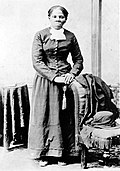Underground Railroad
The Underground Railroad was a secret network of routes and safe houses in the United States. Black slaves used the Underground Railroad to escape from slavery. It was created in the early 1800s, and was at its biggest between 1850 and 1860.[1] The term “Underground Railroad” also describes the abolitionists, both black and white, free and enslaved, who helped the slaves along the way.[2]
Routes on the Underground Railroad led to free states, Canada, Mexico and overseas.[3] While traveling along these routes, slaves received help from abolitionists and those who had sympathy to their cause.[4] British North America was another popular stopping point. Slavery was not allowed there, and its long border gave many points of access. More than 30,000 people were said to have escaped there using the network at its best,[5] although U.S. Census statistics shows only 6,000.[6]
One statistic suggests that by 1850, about 100,000 slaves had escaped to freedom by the "Railroad".[1]
The Underground Railroad fugitives' stories are recorded in the Underground Railroad Records.
Underground Railroad Media
David Ruggles between two men confronting John P. Darg
Freedom seekers escaped to the Great Dismal Swamp's maroon community.
Harriet Tubman (photo H. B. Lindsley), c. 1870. A worker on the Underground Railroad, Tubman made 13 trips to the South, helping to free over 70 people. She led people to the northern free states and Canada. This helped Harriet Tubman gain the name "Moses of Her People".[7]
Quaker abolitionist Levi Coffin and his wife Catherine helped more than 2,000 enslaved people escape to freedom.
Freedom seekers escaped slavery and reached Canada by way of the Niagara Falls Suspension Bridge.
Enslaved people living near rivers and the Chesapeake Bay escaped from slavery using canoes and boats.
Related pages
References
- ↑ 1.0 1.1 Vox, Lisa, "How Did Slaves Resist Slavery?" Archived 2011-07-11 at the Wayback Machine, African-American History, About.com, Retrieved July 17, 2011.
- ↑ "The Underground Railroad". Public Broadcasting Service. Retrieved July 25, 2007.
- ↑ "Purpose and Background". Taking the Train to Freedom. National Park Service. Retrieved July 17, 2011
- ↑ "Underground Railroad". dictionary.com. Retrieved July 17, 2011.
A network of houses and other places abolitionists used to help slaves escape to freedom in the northern states or in Canada...' —American Heritage Dictionary
- ↑ "Settling Canada Underground Railroad". Historica.
Between 1840 and 1860, more than 30,000 American slaves came secretly to Canada and freedom
- ↑ "From slavery to freedom" Archived 2007-07-13 at the Wayback Machine, The Grapevine, pp. 3–5.
- ↑ Clifford Larson 2004, xvii.








